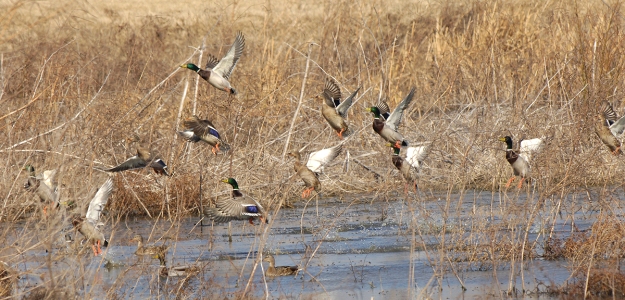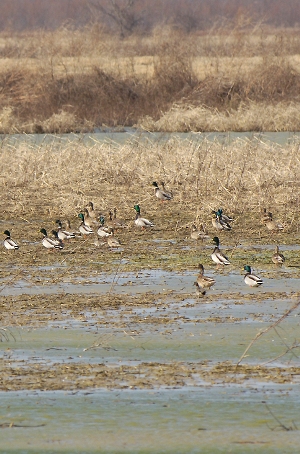
By David Beaty
What if you could provide a situation where you could bring waterfowl up close and personal? If this type of situation is what you are looking for, then this is the article for you. This article deals with managing beaver ponds, greentree reservoirs, and agricultural lands for the opportunity to be up close and personal to one of life’s oldest creatures, waterfowl.
In most parts of the United States, beavers are perceived as a nuisance. For the most part they can be a great deal of trouble, but in this case they may serve as a helpful tool in managing a habitat. With proper management and control, you can successfully turn your beaver pond or slough into a low cost waterfowl haven. Before manipulating any lands covered in water, it is important to contact your district U.S. Army Corps of Engineers to delineate whether the land is considered a wetland. In the case that an impoundment has been flooded due to beavers, it is legal to remove the beaver dams and excess water with the use of explosives.
The first step for managing beaver ponds is to break the dams to allow water to drain off the impoundment to expose mud flats. In this situation, timing is key. The water needs to be drained slowly in late June or early July to allow seed to germinate within a moist seed bed. Another reason for draining the water slowly is to allow the soil to stay moist so aquatic plants will dominate the plant community. In most cases, the land should be disturbed every two to three years to disturb the seed bank. Two ways a moist soil impoundment can be disturbed to promote new growth is through disking or burning. As the summer approaches, new growth of native grasses will fill the impoundment. The new grass may consist of red-rooted sedge (Cyprus spp.), smartweed (Polygonum spp.), or wild millet (Echinochloa spp.). Slowly draining the water also produces a valuable shorebird habitat by producing small puddles, where many invertebrates can be found. During the winter, as the impoundments begin to flood, these invertebrates provide a high source of protein for waterfowl and shorebirds. Due to its high production, and its tolerance to shallow flooding, Japanese millet can be dispersed within the duck pond around July and August. The impoundment should be kept shallow enough so that the water levels stay at least half the height of the millet once established. Around October, as water begins to fill your pond, let the beaver rebuild old dams to catch water within your pond. Doing this will allow nature to work for you at a low cost, low maintenance waterfowl scenario.
 An additional form of moist soil impoundment is the management of a greentree reservoir (GTR). GTRs are generally larger acres of timber which are seasonally flooded during the fall and winter. As with beaver pond management, the most important step is determining whether the lands are considered a wetland before levees can be constructed. The U.S. Army Corps of Engineers will delineate the amount of fill material that can be deposited into the wetland you desire to flood. Seasonally flooding hardwoods requires a series of levees designed to place about 18 to 24 inches of water on flooded timber. This would require a levee with a series of risers and sub-dikes so that water can be removed in late February before the buds on the tree break dormancy. Hardwoods prone to flooding are Swamp Chestnut Oaks, Over cup Oaks, Nut tall Oaks, Cherry bark Oaks, Sweetgums, Black Tupelos, Ashes, Elms, and Bald Cypresses. During the summer, the next step is to design a management plan to thin the hardwoods to promote a large mast production. Mast production is key because they provide late winter food for waterfowl. Thinning the reservoir for mast production also allows for the capability of native grasses to flourish due to the increase in sunlight from the thinning. Careful consideration should be given to the selection of trees which produce small mast which are preferred by wintering waterfowl. Some examples of small acorn producing trees are Water Oak, Willow, Cherry bark, Nut tall, Diamond-Leaf, and Pin Oak.
An additional form of moist soil impoundment is the management of a greentree reservoir (GTR). GTRs are generally larger acres of timber which are seasonally flooded during the fall and winter. As with beaver pond management, the most important step is determining whether the lands are considered a wetland before levees can be constructed. The U.S. Army Corps of Engineers will delineate the amount of fill material that can be deposited into the wetland you desire to flood. Seasonally flooding hardwoods requires a series of levees designed to place about 18 to 24 inches of water on flooded timber. This would require a levee with a series of risers and sub-dikes so that water can be removed in late February before the buds on the tree break dormancy. Hardwoods prone to flooding are Swamp Chestnut Oaks, Over cup Oaks, Nut tall Oaks, Cherry bark Oaks, Sweetgums, Black Tupelos, Ashes, Elms, and Bald Cypresses. During the summer, the next step is to design a management plan to thin the hardwoods to promote a large mast production. Mast production is key because they provide late winter food for waterfowl. Thinning the reservoir for mast production also allows for the capability of native grasses to flourish due to the increase in sunlight from the thinning. Careful consideration should be given to the selection of trees which produce small mast which are preferred by wintering waterfowl. Some examples of small acorn producing trees are Water Oak, Willow, Cherry bark, Nut tall, Diamond-Leaf, and Pin Oak.
The final type of waterfowl impoundment occurs in agricultural land. Agricultural lands used for seasonal flooding are planted fields generally harvested each year. These fields can consist of crops such as soybeans, corn, rice, or sorghum. Levees are constructed around the borders of a field to maintain the optimum water levels through the use of flash board risers. To provide food, cover, and protection for the waterfowl, it is important to leave buffers around the edges of the field uncultivated. In addition to providing the remnants of planted crops, when disking, leave strips within the field during early summer to provide waterfowl with a variety of native grasses. Strips of agricultural crops can be legally flooded for waterfowl as long as they are not manipulated to entice waterfowl by bush hogging or any other means of concentrating grain.
In summary, when managing waterfowl impoundments it is important to check with the U.S. Corps of Engineers, USDA, USFWS or Soil and Water Conservation Services before implementing any type of management plan. By implementing these few ideas on your property, and a little help from Mother Nature, this should provide you with some excellent hunting.




























